When dental labs or practices face the choice of manufacturing implants in-house or outsourcing production, the decision extends beyond cost. It requires weighing investment in equipment and staff, quality and compliance risks, and the ability to adapt to digital technologies. The right model depends on whether flexibility, scalability, or full process control matters most to your organization.
Key factors to evaluate include:
- Cost and ROI: upfront investment in equipment and space versus predictable outsourcing pricing.
- Quality and Risk Management: remake rates, QA processes, and certification compliance.
- Technology Access: CAD/CAM integration, 3D printing capabilities, and innovation support.
- Operational Efficiency: turnaround time, logistics, scalability, and partner communication.
- Strategic Fit: whether long-term growth favors in-house control or external expertise.
By analyzing these dimensions, decision-makers can align implant manufacturing choices with their clinical workflows, business priorities, and growth strategy.
What Are the Core Differences Between In-House and Outsourced Implant Manufacturing?
The core differences between in-house and outsourced implant manufacturing lie in workflow control, resource requirements, and compliance responsibilities. In-house setups require clinics or labs to build their own production lines, while outsourcing leverages the expertise and infrastructure of specialized dental labs. Understanding these distinctions helps decision-makers evaluate which model aligns better with their capacity, risk tolerance, and long-term growth plans.
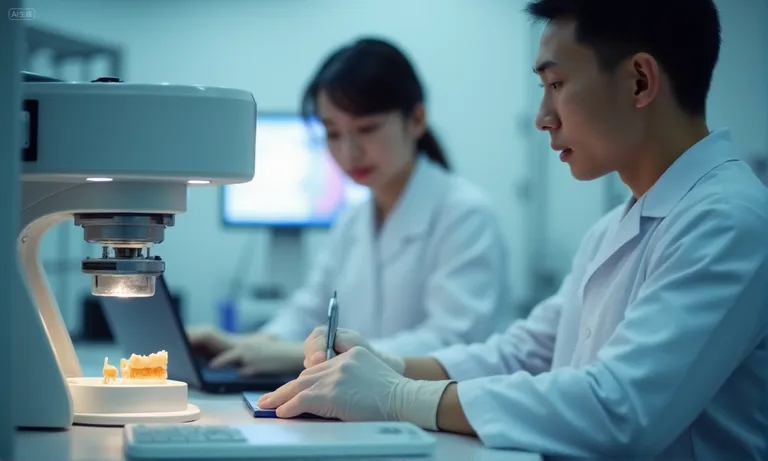
Dental-Implant-InHouse-vs-Outsourcing-Workflow
What does in-house manufacturing involve in terms of workflow and staffing?
Running implant manufacturing in-house means full control over the workflow—from scanning and designing to milling, sintering, and finishing. This requires a dedicated team of trained technicians, often with specialized roles such as CAD designers, milling machine operators, and finishing staff. For a medium-sized dental practice or lab, staffing can account for up to 40% of total operational costs. Beyond wages, managers must plan for continuous training and recruitment to keep pace with new digital systems and materials.
What does outsourcing cover in terms of process and partnership scope?
Outsourcing, by contrast, shifts much of the operational burden to a specialized partner. The external dental lab manages design verification, milling, layering, staining, and final QC before shipping. Some labs even provide case planning support and material guidance. For clinics, outsourcing reduces the need to maintain expensive infrastructure and staff, while still accessing expertise in niche cases such as full-arch zirconia bridges or complex implant abutments. The scope of partnership often includes trial runs, service-level agreements, and ongoing performance reviews, making it a structured collaboration rather than a one-off transaction. For example, many practices rely on OEM dental lab partnerships to extend capacity during peak periods without committing to permanent overhead.
How do space, management, and compliance requirements differ?
In-house setups demand significant physical space—dedicated milling rooms, dust extraction systems, furnace areas, and climate-controlled storage. These facilities must also comply with safety and biomedical waste regulations, adding complexity for management teams. By outsourcing, practices avoid these infrastructure burdens but must ensure their partner adheres to ISO and CE standards, with transparent documentation for traceability. This shifts compliance oversight from internal audits to supplier validation, requiring procurement managers to establish clear verification protocols. From a strategic perspective, outsourcing simplifies daily operations but increases reliance on external partners, while in-house setups enhance independence at the cost of higher managerial and regulatory workload.
Choosing between in-house and outsourcing starts with recognizing these operational and compliance trade-offs. For growing practices, clarity on staffing, space, and partnership expectations makes it easier to assess whether direct investment or external collaboration is the smarter path forward.
Choosing between in-house and outsourced manufacturing is only the first step. To explore the broader outsourcing options, models, and long-term partnership strategies, refer to [How to Evaluate Outsourcing Options for Dental Implant Production], which provides a structured framework for making sourcing decisions.
What Cost and Investment Factors Should Be Compared?
The most critical investment factors to compare between in-house and outsourcing are setup costs, predictable pricing, ROI, and hidden expenses. In-house manufacturing requires heavy upfront investment in equipment and staff, while outsourcing transforms costs into predictable service fees. Decision-makers who weigh these cost structures carefully can better align their financial strategy with long-term practice growth.
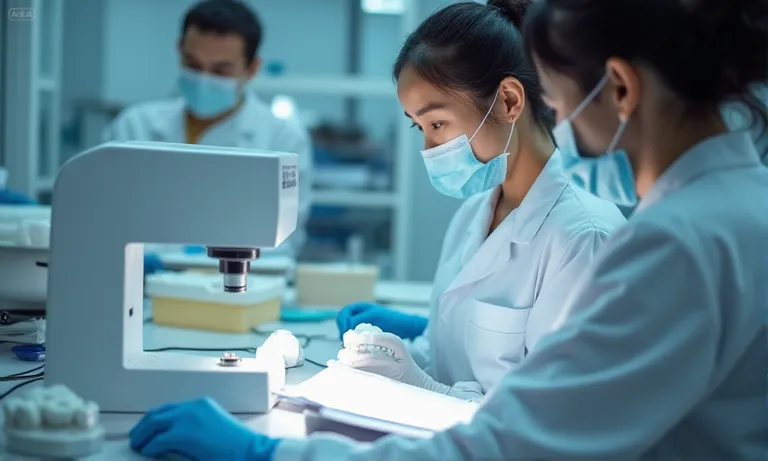
Dental-Implant-Cost-Comparison-InHouse-vs-Outsourcing
How do setup, equipment, and staffing costs affect in-house labs?
| Expense Category | In-House Labs | Outsourcing |
|---|---|---|
| Setup Costs | CAD/CAM systems, milling machines, furnaces, scanners; initial investment can exceed $200,000 | No setup costs; supplier already has infrastructure |
| Staffing | Salaries, training, ongoing recruitment; often 30–40% of lab operating costs | Minimal internal staffing; outsourcing partner provides technicians |
| Maintenance | Machine servicing, software updates, spare parts | Covered by external lab |
| Scaling | Requires additional equipment and hires | Flexible capacity through supplier expansion |
This cost breakdown shows that in-house labs carry significant upfront and ongoing burdens, while outsourcing keeps costs variable and tied to usage.
How predictable are outsourcing costs and pricing structures?
Outsourcing costs are typically structured as per-unit fees, sometimes bundled with shipping or case management. For procurement managers, this creates predictable monthly expenses aligned with case volume. Many overseas dental labs also offer tiered pricing models, where higher case volumes reduce unit cost. The trade-off is less direct control over internal cost allocation, but greater transparency in budgeting compared to fluctuating in-house expenses.
How should ROI and long-term scalability be evaluated?
- In-house ROI depends on case volume—labs need consistent throughput to justify equipment depreciation and staff salaries.
- Outsourcing ROI comes from reduced overhead, faster scaling, and immediate access to specialized expertise without capital investment.
- Scalability is often easier with outsourcing, as suppliers can absorb peak workloads, whereas in-house labs must plan expansions years ahead.
ROI evaluation should balance immediate financial outlay against the lab or clinic’s growth trajectory, weighing whether predictable outsourcing fees or fixed in-house investments align better with future demand.
What hidden costs such as space and training need to be considered?
- Space Requirements: Milling rooms, furnaces, and dust control systems demand costly real estate, which grows with production scale.
- Training Costs: Continuous education for technicians on CAD/CAM, materials, and new workflows can quickly add up.
- Compliance Expenses: In-house facilities must undergo audits and maintain certifications, while outsourcing shifts these costs to the supplier.
These less visible costs often tilt the balance toward outsourcing, especially for clinics or DSOs that prioritize financial flexibility.
Comparing costs goes beyond the surface of equipment versus service fees. Factoring in ROI, scalability, and hidden expenses allows decision-makers to understand the true long-term financial impact of each model, making it easier to match investment strategy with practice growth.
How Does Each Option Influence Quality and Risk Management?
Quality and risk management differ sharply between in-house and outsourced manufacturing. In-house teams control every production step but face resource and expertise limitations, while outsourcing relies on specialized labs with established QA protocols, shifting risk away from the clinic. For procurement managers, the key is understanding how these trade-offs affect remake rates, compliance, and long-term reliability.

Dental-Implant-Quality-Control-InHouse-vs-Outsourcing
What quality control measures are feasible in-house vs outsourced?
- In-house: Clinics or labs can implement hands-on checks at each step, such as verifying STL files, articulating occlusion, and polishing margins. However, quality often depends on the experience of a small technician team, which increases variability.
- Outsourcing: Specialized dental labs standardize quality control with multiple checkpoints, including CAD verification, machine calibration, and independent QC staff review. Many overseas partners also maintain digital archives of case files, creating traceability that small in-house teams may struggle to achieve.
How do remake rates, QA processes, and warranties compare?
| Factor | In-House Manufacturing | Outsourced Manufacturing |
|---|---|---|
| Remake Rates | Often higher for complex cases if staff lack specialized training | Generally lower due to standardized processes and advanced equipment |
| QA Processes | Manual checks; varies with technician expertise | Structured QA systems, multi-step inspection, digital traceability |
| Warranties | Rarely formalized; responsibility falls on clinic/lab | Many suppliers offer written warranties or remake policies |
This comparison shows why outsourcing is often preferred for consistency: quality systems are more formalized and backed by contractual agreements, reducing financial and reputational risk.
Which compliance and certification requirements matter most?
In-house setups must comply with local biomedical and occupational standards, often requiring regular audits and staff training. Outsourcing partners, particularly those exporting to the US or EU, typically carry certifications such as ISO 13485, CE marking, or FDA registration. For procurement managers, verifying these certifications is essential—ensuring the supplier follows international benchmarks for material safety and device quality. For example, ISO 13485 certification is a clear signal that a lab’s processes meet global medical device standards, offering assurance that goes beyond internal checks.
For decision-makers, the contrast is clear: in-house provides direct oversight but limited scalability, while outsourcing delivers standardized QA and stronger compliance coverage. Balancing these factors helps clinics and DSOs decide which model minimizes risk while sustaining consistent quality.
How Do Technology and Workflow Integration Affect the Choice?
Technology and workflow integration often determine whether in-house or outsourced implant manufacturing is the more strategic option. In-house setups demand significant technical expertise and equipment investment, while outsourcing provides immediate access to advanced systems like CAD/CAM, 3D printing, and new material options. For decision-makers, the trade-off is between control and innovation speed.
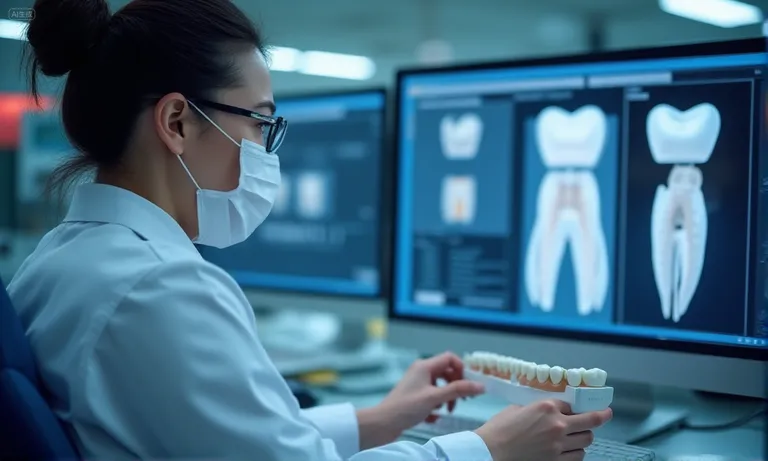
Dental-Implant-Digital-Workflow-InHouse-vs-Outsourcing
How is CAD/CAM and digital workflow integration handled in each model?
- In-house: The lab manages scanning, CAD design, and milling in a closed-loop system. Integration requires compatible scanners, CAM software, and milling machines, which often come from different vendors.
- Outsourcing: Files can be shared through open-source formats like STL or cloud-based portals, allowing seamless compatibility across platforms. Many outsourcing labs provide digital design feedback before production, reducing errors and turnaround time.
- Hybrid workflows: Some clinics design restorations in-house but outsource milling, combining control over design with the scalability of external production.
What technical expertise and equipment are required in-house?
Operating an in-house digital workflow demands more than purchasing hardware. Staff must be trained to use CAD software, calibrate milling machines, and manage maintenance cycles. Equipment like furnaces, scanners, and 3D printers require routine updates and consumables, which adds both cost and learning curve. For many clinics, the challenge is not acquiring the technology but sustaining the expertise needed to run it efficiently. Without continuous training, errors in margin definition, occlusion design, or printer calibration can lead to higher remake rates and wasted materials.
How does outsourcing provide access to new technology like 3D printing and materials?
| Technology Area | In-House Capacity | Outsourced Advantage |
|---|---|---|
| CAD/CAM Systems | Requires direct investment and upgrades | Supplier continuously updates systems for best-in-class performance |
| 3D Printing | High upfront cost; limited printer types | Access to multiple printer technologies and material options |
| Materials | Stock limited by budget and storage | Supplier offers wide portfolio, including latest zirconia and hybrid composites |
| Innovation | Dependent on staff training and vendor support | Partner provides immediate access to innovations tested across global cases |
By outsourcing, practices can leverage cutting-edge tools without bearing the full cost of constant upgrades. This access to innovation is especially valuable for DSOs or distributors who need flexibility across diverse case types.
Technology decisions often hinge on balancing independence with access. In-house models offer control but require constant reinvestment, while outsourcing ensures immediate exposure to new workflows and materials. Clinics and DSOs that prioritize innovation speed and integration efficiency often find external partnerships the more scalable choice.
What Are the Operational and Delivery Implications?
Operational and delivery implications often shape the practical choice between in-house and outsourced manufacturing. Turnaround time, logistics, workload flexibility, and scalability are the key factors that determine whether a practice can meet patient expectations consistently. In-house setups offer control over scheduling, while outsourcing provides capacity expansion and access to established logistics systems.
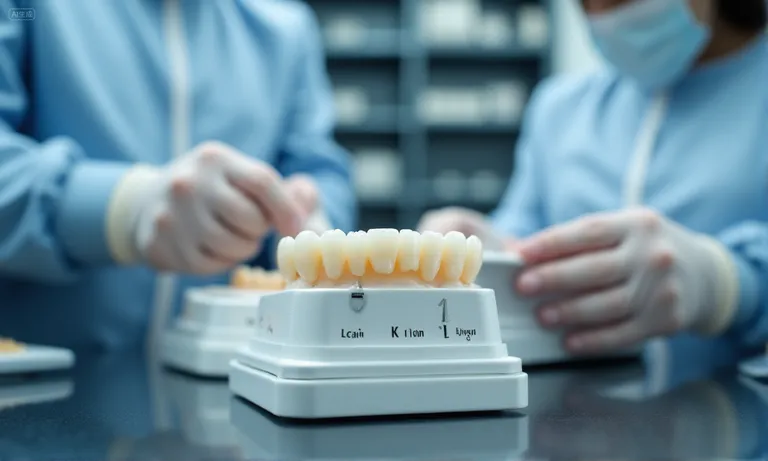
Image
ALT: Dental-Implant-Operational-Delivery-Comparison
Prompt:
A highly realistic, ultra-detailed, professional-quality photo captured in a clean, well-lit dental lab environment. Materials must be photorealistic, anatomically accurate, and rendered with DSLR-level clarity. Lighting should be soft daylight or studio white light, avoiding cold or bluish clinical tones. Each tooth showing slight variation in contour, size, and cusp height, with natural occlusal grooves, realistic contact points, enamel translucency, and subtle shade gradient from incisal edge to cervical area; microscopic surface texture and slight asymmetry typical of natural dentition.
→ A Chinese dental technician is packaging finished implant crowns into labeled shipping boxes, while a courier pickup is visible in the background, symbolizing outsourcing logistics, contrasted with another technician scheduling milling runs for in-house cases on a whiteboard.
How do turnaround times typically compare between in-house and outsourcing?
- In-house: Turnaround is often faster for single-unit or urgent cases, since production can be prioritized immediately.
- Outsourcing: While shipping adds extra days, many overseas dental labs have optimized production pipelines to deliver consistent 7–10 day cycles internationally.
- Hybrid setups: Some clinics combine the two—using in-house for same-day units and outsourcing for complex or high-volume cases, balancing speed and efficiency.
What logistics, shipping, and communication challenges arise with outsourcing?
Outsourcing requires effective case tracking and shipping reliability. Practices must account for customs clearance, courier delays, and time zone differences when coordinating with overseas labs. Communication protocols such as digital portals, 24-hour response policies, and case dashboards are critical to minimize miscommunication. When these systems are in place, outsourcing can achieve predictable delivery timelines; without them, small errors in documentation can snowball into multi-day delays.
How does each model handle workload peaks and labor shortages?
| Factor | In-House | Outsourcing |
|---|---|---|
| Peak Demand | Limited by available staff and machine capacity | Suppliers can absorb surges by allocating additional resources |
| Labor Shortages | Directly impacts turnaround; fewer technicians = slower output | Impact mitigated; outsourcing spreads risk across larger teams |
| Flexibility | Requires cross-training and overtime | Scalable through supplier’s distributed workforce |
This shows why outsourcing is often favored during seasonal demand spikes or staff turnover periods: external partners maintain continuity even when internal resources are stretched.
How scalable is each approach for growing practices or labs?
- In-house scaling: Requires new equipment purchases, expanded facilities, and recruitment—changes that may take months or years.
- Outsourcing scaling: Achieved quickly by increasing case volume with the supplier, usually under existing service agreements.
- Hybrid path: Some DSOs scale strategically by outsourcing high-complexity cases first, then investing gradually in selective in-house capacity.
Scalability is often the deciding factor: outsourcing adapts quickly to growth, while in-house expansion demands long-term capital planning and management bandwidth.
Operationally, the trade-off is clear. In-house labs excel in immediate control and urgent cases, while outsourcing delivers consistency, flexibility, and scalability for sustained growth. For procurement managers, aligning the delivery model with patient demand patterns ensures efficiency without compromising quality.
When Does Outsourcing or In-House Make the Most Strategic Sense?
The strategic choice between in-house and outsourcing depends on practice size, growth stage, and operational priorities. Outsourcing delivers flexibility and access to expertise, while in-house manufacturing provides independence and tighter scheduling control. Knowing when each option makes sense helps decision-makers avoid costly misalignment with patient demand and long-term business goals.
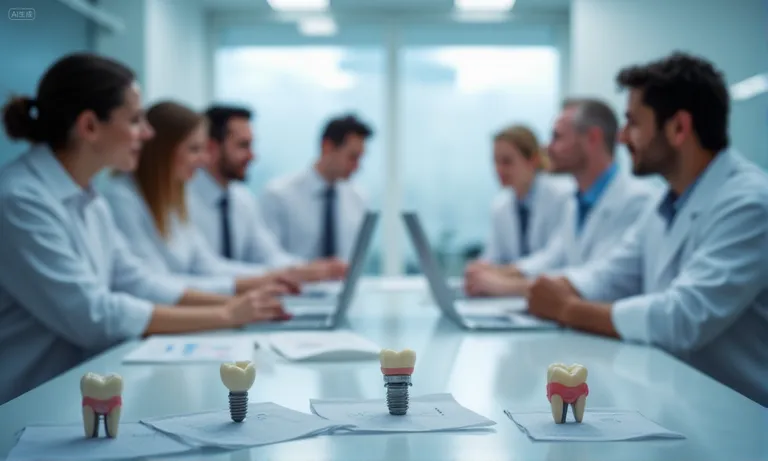
Dental-Implant-Strategic-Decision-InHouse-vs-Outsourcing
In what scenarios does outsourcing deliver the most value?
- High-volume or peak demand periods where external labs absorb overflow quickly.
- Complex restorations such as full-arch zirconia or angled screw-retained abutments, which require advanced equipment and expertise.
- Clinics or DSOs expanding rapidly that need scalable production without tying up capital in new equipment.
- Practices prioritizing financial flexibility and preferring predictable per-case pricing models.
When is it more strategic to keep implant manufacturing in-house?
- Urgent turnaround needs such as same-day crowns or emergency single-unit cases where immediate chairside control matters.
- Large practices with stable high volume that can justify the investment in equipment and staff while spreading costs over many cases.
- Clinics seeking maximum independence from external partners, reducing reliance on logistics and shipping.
- Organizations with strong internal expertise and the resources to maintain compliance and continuous training.
How should decision-makers balance short-term needs with long-term growth?
In the short term, outsourcing reduces risk and accelerates access to technology, while in-house setups require higher upfront costs but can deliver independence over time. Many DSOs adopt a hybrid path: outsourcing advanced or bulk cases first, then gradually building internal capabilities as volume stabilizes. This blended approach allows flexibility in growth stages while ensuring patient care is never compromised. Strategic balance comes from aligning the delivery model with both financial realities and the clinic’s projected case mix.
Ultimately, outsourcing favors flexibility and innovation access, while in-house favors control and independence. Practices that match their production model to growth stage and patient demand will gain the most strategic advantage in the long run.
Conclusion
Choosing between in-house manufacturing and outsourcing is ultimately about aligning resources with strategy. In-house setups provide control, independence, and immediate chairside responsiveness, but require heavy investment in space, staff, and compliance. Outsourcing, on the other hand, offers scalability, predictable costs, and access to advanced technologies without locking capital into infrastructure. For many clinics and DSOs, the most sustainable path is a hybrid model, starting with external support and gradually building in-house capabilities. As an overseas dental lab, we often act as a flexible extension of the clinical team, helping partners reduce risk while maintaining high-quality, consistent outcomes.


